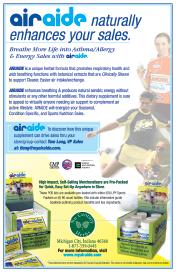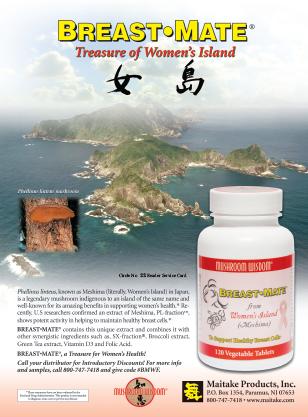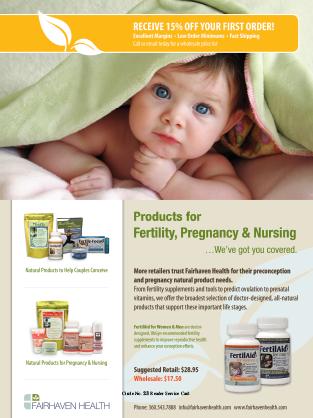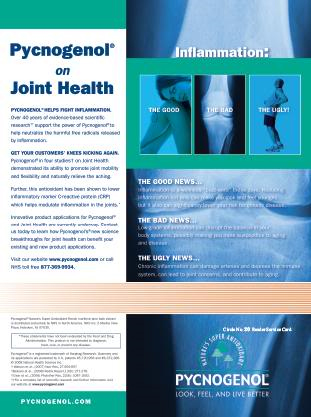Women evolve through many roles in their lives: daughters, sisters, career women, wives, mothers, friends, grandmothers, and perhaps all of these at once. But throughout all these phases, one thing remains constant: the need to take a proactive healthcare stance during each of these unique stages of a woman’s life.
Marci Clow, MS, RD, senior director of product research at Rainbow Light Nutritional Systems, Santa Cruz, CA, says, “Women embrace a unique physical journey throughout life, with changes initially manifesting during puberty with the onset of menses, subsequently with pregnancy, motherhood and later, menopause. These stages of the female life cycle bid significant physiological and emotional adaptations. Combining healthy diet and lifestyle with appropriate nutrient and botanical support can facilitate and ease these life cycle changes, promoting metabolic and hormonal harmony.”
 Getting a Fair Share of Care
Getting a Fair Share of Care
Young girls are told to take their multivitamins. Teens are advised to eat well and can find a slew of teen-specific supplements. But as soon as women hit the age of 20, there seems to be a void on store shelves. Bodies change, and women can’t be expected to follow the same routines they did in their teens. Women can’t afford to stand by idly for 10 years or so, until childbirth or menopause, to utilize the next good round of demographic-specific supplements, advice or products.
“The nutritional needs of women in their twenties are considerably downplayed in light of the emphasis placed on the teenage, menopausal and childbearing years. This does not, however, make this period of time any less important in life’s big picture,” says Jayson Kroner, CSN, health and fitness editor for NOW Foods, Bloomingdale, IL.
Retailers should give this age group some special attention, because after those 10 years have been wasted with no supplemental support, the damage will be done. Prevention should be emphasized during these years, and the foundations should be set for a lifetime of healthy choices. Set up a section of the store or an endcap devoted to this unique demographic.
 Keri Marshall, MS, ND, medical director for Gaia Herbs, Brevard, NC, notes: “In the post-college and early years of career development, women are often faced with having to reinvent themselves and with this comes prolonged times of stress. Many women are dealing with issues related to ‘settling down,’ whether it means in a career, a relationship or beginning a family. Because stress levels are often so high during this time and sleep may be limited, such as late nights and waking early for a job, the adrenal glands and thyroid gland also begin to suffer.” Also, says Marshall, “these are the same endocrine glands that produce the hormone DHEA, which plays a role in libido,” which is important for young women beginning to explore their sexuality.
Keri Marshall, MS, ND, medical director for Gaia Herbs, Brevard, NC, notes: “In the post-college and early years of career development, women are often faced with having to reinvent themselves and with this comes prolonged times of stress. Many women are dealing with issues related to ‘settling down,’ whether it means in a career, a relationship or beginning a family. Because stress levels are often so high during this time and sleep may be limited, such as late nights and waking early for a job, the adrenal glands and thyroid gland also begin to suffer.” Also, says Marshall, “these are the same endocrine glands that produce the hormone DHEA, which plays a role in libido,” which is important for young women beginning to explore their sexuality.
But stress affects more than one’s sex life. Kroner says, “This is important to keep in mind, because an individual’s ability to manage stress can, quite literally, make all the difference in their total health status. Stress is an all-too-common precursor to weight gain, which affects cardiovascular and hormonal health, which can in turn, affect metabolism, blood sugar health, structural integrity and so on. Stress has also been shown to undermine the immune system.”
Prevention. It is imperative that women in their twenties take preventative action to ensure that stress and nutritional neglect do not take a toll on health in the long run. For example, “Many experts agree that the initial symptoms of osteoporosis can set in years earlier than once imagined, further fueling the need for vitamin D, calcium and magnesium, and vitamin K,” emphasizes Kroner.
 Kate Jones, vice president of Nutrition Now, Vancouver, WA, agrees. “Between the ages of 20 and 50, a woman can lose more than one-third of the total calcium in her bones. Eating a calcium-rich diet along with supplementation can help women get their recommended daily intake of calcium and maintain optimum bone health. It is also important to stay away from a diet that hinders calcium absorption such as foods that contain caffeine, sugar and phosphorus,” she says.
Kate Jones, vice president of Nutrition Now, Vancouver, WA, agrees. “Between the ages of 20 and 50, a woman can lose more than one-third of the total calcium in her bones. Eating a calcium-rich diet along with supplementation can help women get their recommended daily intake of calcium and maintain optimum bone health. It is also important to stay away from a diet that hinders calcium absorption such as foods that contain caffeine, sugar and phosphorus,” she says.
In addition to bone health, anemia is another common concern that leaves many young women feeling fatigued or prone to other medical problems. Amy Fitzpatrick, MS, RD, corporate dietician for Chatsworth, CA-based Natrol, adds, “Iron is another often overlooked nutrient for this age group. Iron-deficiency anemia is more common in women of childbearing age, especially vegetarians, so a daily multi with at least 50% of the daily value (DV) for this essential mineral is important.”
In general though, the greatest concern for women is reproductive health. According to Marshall, “The single most important thing is to have a healthy menstrual cycle. What this means is that it should come roughly every 28 days, is not excessive in flow, and that a woman experiences little to no physical or emotional discomfort in the week preceding her cycle. If a woman’s cycle is off, inevitably so are many other things in her life.”
Deanne Dolnick, director of sales for Next Pharmaceuticals, Salinas, CA, emphasizes the importance of sleep in relieving symptoms associated with PMS and menopause. There are also numerous supplements to help ease discomfort, which will be discussed later in this article.
Indeed, maintaining reproductive health is essential for a healthy pregnancy and giving birth to healthy babies in the future. In fact, according to a National Vital Statistics Report referenced by Gene Bruno, MS, MHS, consultant for Los Angeles, CA-based Jarrow Formulas and dean of academics at Huntington College of Health Sciences, birth rates for women in their twenties increased by two percent between 2006 and 2007 with the average age of for first-time mothers being 25. Therefore, it’s even more important for women to get an early start on proper nutrition.
Another common issue is weight management. According to Bob Green, president of Nutratech, West Caldwell, NJ, more than 62% of adult women in the United States are overweight and 34% are obese. He notes several conditions that exclusively or primarily affect women resulting from obesity as an underlying risk factor: arthritis, birth defects, breast cancer, cardiovascular diseases, endometrial cancer, gallbladder disease, infertility and urinary stress incontinence.
Therefore, it is crucial that women maintain a healthy weight through proper diet and exercise and, according to Green, thermogenic weight-loss supplements can also help. Bitter orange, also called citrus aurantium, is one of these, as well as Garcinia cambogia.
Because of the go-go-go nature of many women’s lives, it may be difficult to avoid eating the wrong foods when in a hurry, but it may also be tough to avoid exposure to environmental toxins, which can cause lasting damage to the skin, lungs and other organs. Fitzpatrick says, “Twenty-somethings are often exposed to tobacco smoke (first- or second-hand) and ultraviolet light, and may have unhealthy dietary practices that increase the production of free radicals that can cause cellular damage.” She recommends antioxidant supplementation to counteract this, especially for women who are sun-worshipers or who live in urban areas. These antioxidants can include lycopene, vitamin C, vitamin E, selenium and green tea.
Holly Lucille, ND, RD, for Enzymatic Therapy, Green Bay, WI, agrees, “Avoiding as many environmental toxins as possible is vital for women in their twenties and taking a super antioxidant supplement like resveratrol, is an excellent way to fight free radicals and oxidative damage.”
Retailers can address this topic by creating a display promoting rejuvenation and detoxification for women on-the-go that can include supplements, snacks and health and beauty products.
Keeping Abreast of the Issues
Environmental toxins aren’t always found out in busy city streets—they can lurk right in the products that women trust every day. One of the leading causes of breast and other forms of cancer is thought to be xenoestrogens, or environmental estrogens that can be found in plastics, feminine hygiene products, pesticide-laden foods and so on. Cosmetics containing parabens are also thought to be particularly troublesome. A study in the Journal of Applied Toxicology indicated that parabens were found in 18 of 20 breast tumors (1)—parabens that are often found in cosmetics and deodorants.
|
Ins-and-Outs of Beauty
Eileen Sheets, managing director at Bioforce USA, Ghent, NY, says, “In the 1970s, the Ivory Girl represented pure, natural, glowing beauty and we at Bioforce celebrate that iconic image and the empowerment it projects. To that end, we provide one of the world’s most venerable natural hair colors (36 shades), Herbatint, and Hubner Original Silica Gel, which a study has shown to thicken hair by approximately 13% during six months of supplementation. The other benefit of this product is strong, healthy nails.” A healthy, beautiful outside must also come from within, literally. Gene Bruno, consultant for Los Angeles, CA-based Jarrow Formulas and dean of academics at Huntington College of Health Sciences, adds, “The old adage, ‘Beauty begins on the inside,’ has a physiological basis as well as philosophical one. The appearance of beautiful hair, skin and nails can be enhanced with contributions of various nutrients or natural substances. These include silicon (stabilized silicic acid molecular clusters), vitamin C, hyaluronic acid and alpha lipoic acid.” |
These xenoestrogens and estrogen-mimicking compounds may “cause our own estrogen to convert to cancer-causing forms of estrogen; they increase our risk of breast, ovarian and endometrial cancer; they promote infertility by suppressing progesterone; and they cause early puberty” (2).
Also, estrogens used in hormone replacement therapy (HRT) have been associated with increased risks. In July 2002, a Women’s Health Initiative study regarding HRT was halted when researchers noted an increased risk of blood clots, breast cancer, coronary heart disease and stroke in participants. The study group was found to have a 26% increase in the risk of invasive breast cancer (2).
Being overweight or obese also increases estrogen stores in fat, and can also contribute to increased breast cancer risk (2).
Herb Joiner-Bey, ND, scientific advisor to Barlean’s Organic Oils, Ferndale, WA, says, “Estrogens contribute to risk for breast and uterine cancer by promoting the growth of tissue in these organs during the monthly menstrual cycle. If DNA in these tissues has been damaged or inherited cancer genes have been activated, the cell-multiplying of female hormones promotes the development of malignancy. It is very prudent for women to start protecting themselves as early as possible to minimize undesirable effects of estrogens on breast tissue and the expression of cancer genes.”
In addition to monthly breast exams, women can proactively address breast health though nutrition and supplementation. To pay homage to October being Breast Cancer awareness month, it might be a good idea for retailers to set up a breast health display or hand out literature about the following supplements.
The big player in breast health lately has been vitamin D. A population-based case-control study (3) assessed the relationship between sources of vitamin D and breast cancer risk, finding, “strong evidence to support the hypothesis that vitamin D could help prevent breast cancer. However, our results suggest that exposure earlier in life, particularly during breast development, may be most relevant. These results should be confirmed.”
Results of the study showed reduced breast cancer risks were associated with increasing sun exposure from ages 10 to 19 (odds ratios [OR], 0.65; 95% confidence intervals [CI], 0.50-0.85 for the highest quartile of outdoor activities versus the lowest; P for trend = 0.0006). Reduced risk was also associated with cod liver oil use (OR, 0.76; 95% CI, 0.62-0.92) and increasing milk consumption (OR, 0.62 95% CI 0.45-0.86 for 10 glasses per week versus none; P for trend = 0.0004). There was weaker evidence for associations from ages 20 to 29 and no evidence for ages 45 to 54, which, again, implies that early prevention is essential.
Joiner-Bey adds that the omega-3 fatty acid ALA (alpha-linoleic acid) in flaxseed oil can help reduce risk of breast cancer metastis and recommends a dose of one tablespoon per 100 pounds of body weight. He also says, “The lignans in flaxseed are phytoestrogens, plant compounds with extremely mild estrogenic influence that reduce the tissue effects of powerful human estrogens and help reduce the release of excess estrogens from fat tissue. The dosage of flaxseed lignan SDG (secoisolariciresinol diglycoside) [Barlean’s Brevail] necessary for real breast protection is 50 mg daily.”
Other recommendations (2, 4) for breast health include:
- A multivitamin to cover all bases and create a healthy starting point.
- Milk thistle supports liver health, which is important for the metabolism of hormones.
- Calcium D-glucarate is important for estrogen metabolism and detoxifying breast cancer-promoting agents.
- Turmeric helps to break down toxins in the liver and prevents carcinogens form forming, possesses anti-inflammatory properties, has potent antioxidants while also stimulating the immune system. Turmeric also acts as a COX-2 inhibitor and helps prevent tumor growth, induces apoptosis and inhibits cell proliferation.
- Chaste tree, often called vitex, can help balance the estrogen to progesterone ratio.
- Evening primrose oil can help control inflammation.
- Rosemary extract can reduce tumor formation and breast lumps.
- A recent study shows that the Meshima mushroom “inhibits proliferation (anchorage-dependent growth) as well as colony formation (anchorage-independent growth) of highly invasive human breast cancer cells,” “suppresses invasive behavior of MDA-MB-231 cells by the inhibition of cell adhesion, cell migration and cell invasion,” and “suppresses breast cancer cell-mediated angiogenesis of endothelial cells in vitro” (5).
|
Select Product Offerings
Barlean’s Organic Oils: Organic High-Lignan Flaxseed Oil; Brevail, a flaxseed lignan concentrate in a caplet, for breast health; Forti-Flax; new Essential Woman Swirl contains flaxseed oil, gamma-linolenic acid, evening primrose oil, lignans and rosemary in a chocolate-raspberry smoothie flavor. Bioforce USA: Sage Menopause, Hubner Original Silica Gel, Herbatint. Enzymatic Therapy: EstroBalance, Resveratrol-forte, Eskimo-3 fish oil, Fatigued to Fantastic Adrenal Stress-End, Remifemin for menopause relief. Gaia Herbs: Chaste Tree Berry High Potency Liquid Extract for progesterone regulation; Adrenal Health Liquid Phytocaps to modulate stress; Thyroid Support Liquid Phytocaps to help normalize metabolism; Phyto-Estrogen Liquid Phytocaps for menopausal support. Herbalist & Alchemist: A full line of herbal extracts and formulas. Himalaya Herbal Healthcare USA: MenstriCare; MenoCare; and StressCare for adrenal support. Jarrow Formulas: Preg-Natal DHA contains extra folic acid, calcium and iron for proper fetal development. JarroSil is a patent-pending Activated Silcon formula. Skin Optimizer includes vitamin C, hyaluronic acid, alpha-lipoic acid and pomegranate. MenstraCalm utilizes Chaste tree berry, vitamin B6, magnesium and Dong Quai for monthy support. Midlife Ease provides phytoestrogens including licorice, lignans and pomegranate and herbs such as eleuthero, Schizandra and valerian for well being during menopause. Fem-Dophilus helps maintain vaginal and urinary balance. Maitake Products: Breast•Mate supports healthy breast cells. Natracare: Offers a full range of organic and natural feminine hygiene products made from chlorine-free and plastic-free, renewable and compostable materials. Natrol: My Favorite Multiple for Women is found in several varieties including My Favorite Multiple Prime with extra vitamin D for breast health and My Favorite Multiple PreNatal Care. Natrol PMS Control contains an array of herbs and B vitamins. Natrol Promensil, Natrol Complete Balance for Menopause AM/PM Formula and Natrol Black Cohosh support women with menopausal symptoms. Natrol Cranberry offers urinary tract support. Natrol DHEA for hormonal support. Natrol Extreme Omega offers heart and mood benefits. Natrol Skin, Hair, Nails and BioSil nourish and beautify from the inside-out. Natural Health Science: Pycnogenol, French maritime pine bark. NOW Foods: Eve is a comprehensive women’s multiple; Derma Vits for hair, skin and nails; D-Mannose for urinary health; Menopause Support; Female Balance; Red Clover; Black Cohosh; Soy Isoflavone; Cranberry. Next Pharmaceuticals: Relora is an herbal combination to help ease stress related to PMS; Seditol helps support healthy sleep patterns for menopausal/perimenopausal women. Nordic Naturals: Prenatal DHA for mood support, proper neurological function and proper infant development; Omega Women for women of all ages; EPA Xtra provides therapeutic levels of EPA to help balance prostglandins and benefit cardiovascular health. Nutratech: Advantra Z is an all-natural, thermogenic ingredient for weight loss and fitness. Nutrition Now: Adult Gummy Multi-Vitamins; PB8 Pro-Biotic Acidophilus; PMS Support. Rainbow Light Nutritional Systems: Prenatal One, Complete Prenatal System and Prenatal Petite; PMS Relief; Complete Menopause Multivitamin, Menopause One, Black Cohosh Meno-Relief 1650 and Women’s Answer Multi+ Daily Program. Willow Pads: Reusable cotton and hemp menstrual pads. Wise Essentials: Bio-Identical Natural Progesterone Cream. |
Others noted supplements include Ginko biloba, ginseng, garlic, green tea, broccoli and broccoli seed, and wheat germ (6).
Gestating Ideas about Healthy Pregnancy
Should a woman choose to become pregnant, there are some crucial steps she needs to take to support a healthy pregnancy. A multivitamin from a trustworthy manufacturer is an obvious and essential choice for mothers-to-be. Many brands are specifically formulated for pregnant women to deliver specific essential nutrients.
It is consistently reported that Americans’ diets are deficient in essential fatty acids (EFAs). This can be extremely detrimental to health, but especially in regards to pregnancy, when levels of DHA (docosahexaenoic acid) are deficient. According to Tori Hudson, ND, advisory board member at Nordic Naturals, Watsonville, CA, “DHA comprises about 20% of the fatty tissue in the brain and is essential for proper development of the brain, eyes, nerves and immune system.” The supplement is beneficial from pre-conception through post-partum to regulate the development of the fetus and also maintain mom’s cardiovascular and mental health. Because eating fish frequently raises concerns about mercury intake, supplemental omegas are an ideal solution when they are highly purified.
Joiner-Bey recommends a dosage of 200–300 mg daily of DHA during pregnancy. He also notes that flaxseed oil can also be helpful as a source of ALA. He says, “Estrogens in women of reproductive years enhance the conversion of omega-3 ALA into the longer omega-3s EPA and DHA.”
Women of childbearing age should also be sure they get enough folic acid. According to Bruno, “Birth deformities such as cleft palate, spina bifida, brain damage and neural tube defects may result from an inadequate supply of folic acid.” Also, it is important for cell division during pregnancy, he says, and recommends as per the Food and Nutrition Board guidelines, that pregnant women get 800 mcg of folic acid daily. In addition, folic acid will help maintain cervical cell health even before conception.
Another important issue during pregnancy is maintaining adequate levels of calcium. “Pregnant women have an increased need for calcium, due to the formation of the fetal skeleton, and should be getting 100 mg daily,” says Bruno. “If the diet does not provide adequate calcium, the mother’s own bones may be leached of calcium to provide for the needs of the fetus. During the third trimester (29 to 40 weeks), calcium is especially needed for proper bone and tooth growth.”
Bruno also notes the importance of iron supplementation. A growing baby will store iron for use after birth, which can make the mother deficient. Iron is important for carrying oxygen throughout the body; Bruno recommends 27 mg of iron daily for pregnant women.
Be careful. Extra care is certainly necessary when it comes to supplements and pregnancy. Kroner notes, “There are some herbs and specialized supplements that are best avoided during pregnancy. Some are known to induce miscarriage in certain quantities. Blue cohosh and pennyroyal head this list. Others, such as adrographis, boldo, catnip, feverfew, juniper, licorice, nettle, red clover, rosemary, sheperd’s purse, yarrow and most essential oils should be used with extreme caution or under a medical professional’s care,” says Kroner.
Moms-to-be may also want to avoid plastic products containing bisphenol-A, as a developing fetus may be negatively influenced because of it.
Regarding this and other toxins, Grace Ormstein, MD, CTN, Ph.D., scientific advisor for Himalaya Herbal Healthcare, Houston, TX suggests that women who are planning to become pregnant should consider cleansing or detoxing before doing so. “Their program should cleanse the liver, the colon, the kidneys, the blood and the lymphatic system,” she says. She agrees that women should not take herbal supplements during pregnancy, but “a pregnant woman should instead follow a healthy diet and a suitable exercise program,” and be monitored by a healthcare professional.
Natural Comfort
Although change is what makes a woman’s life special and unique, she may face discomfort from these changes in the forms of PMS (pre-menstrual syndrome), peri-menopause and menopause. Although these are different conditions, there are certain supplements that can be used effectively for both. Frank Schönlau, Ph.D., director of scientific communications for Horphag Research and Natural Health Science, Hoboken, NJ, notes a double-blind, placebo-controlled trial in which French maritime pine bark (Pycnogenol) decreased a broad range of symptoms including hot flashes, menstrual problems, vaginal dryness and also anxiety, depression and sleeping problems (7).
On the other hand, David Winston, RH (AHG), founder of Herbalist & Alchemist, Washington, NJ, says, “If I had to choose a single herb for PMS and peri-menopausal symptoms it would be chaste tree (vitex agnus-castus),” but also notes that he prefers to recommend a combination of herbs.
Marshall agrees about vitex: “Chaste tree berry helps the body maintain normal levels of progesterone during the menstrual cycle. It is a great alternative for women choosing not to do traditional hormone therapies, including the birth-control pill and HRT. It is also a very useful botanical for perimenopause because progesterone levels are always the first to lower, even before estrogen. Chaste tree used during this time can help normalize so many of the intense feelings that are common with perimenopause.”
In general, says Lucille of Enzymatic Therapy, “CAM and natural treatments are more effective because they address the cause, not just the symptoms.”
PMS. Too often women rely on over-the-counter pain relievers for symptoms of PMS, which can be damaging in the long term, and often not address the cause of the discomfort. Clow says, “PMS is estimated to affect 30–40% of menstruating women. An elevated estrogen-to-progesterone ratio, elevated prolactin and aldosterone levels, hypothyroidism, impaired liver function and reduced serotonin and endorphin levels are common physiological changes that occur in women with PMS.”
Also, women often wait for too long into their cycles to take action. PMS relief starts “with a diet that is high in fiber and lower in saturated fats and higher in ‘good fats’ such as nuts/seeds, fish, fish oil and olive oil,” says Hudson.
Winston notes that PMS symptoms can be divided into categories for more effective relief: PMS-H (hyperhydration) can be helped with natural diuretics such as nettle leaf and parsley; PMS-A (anxiety) can be addressed with herbs like chaste tree, motherwort and ashwagandha, as well as magnesium; PMS-D (depression) may be helped with black cohosh, St. John’s wort, holy basil and lemon balm; PMS-C (cravings) can also be addressed with magnesium, blood sugar management and from herbs such as fenugreek and dandelion root; and PMS-P (pain) is often helped with fish oils, turmeric and traditional uterine analgesics such as black haw, Roman chamomile, cramp bark and Jamaica dogwood.
 Menopause/perimenopause. Menopause can often be an emotionally- trying and physically frustrating time for women. Conventional therapies include HRT, estrogen replacement therapy (ERT) and menopausal hormonal therapy (MHT). Premarin, a preparation of conjugated estrogen derived from pregnant horses (!), is a common example of one of these therapies. Despite the obvious DNA mismatch from horses to humans, these estrogen therapies in long-term use have been associated with various types of cancers, as previously mentioned. A 2002 study found “women who used estrogen-only replacement therapy, particularly for 10 or more years, were at significantly increased risk of ovarian cancer in this study”(8).
Menopause/perimenopause. Menopause can often be an emotionally- trying and physically frustrating time for women. Conventional therapies include HRT, estrogen replacement therapy (ERT) and menopausal hormonal therapy (MHT). Premarin, a preparation of conjugated estrogen derived from pregnant horses (!), is a common example of one of these therapies. Despite the obvious DNA mismatch from horses to humans, these estrogen therapies in long-term use have been associated with various types of cancers, as previously mentioned. A 2002 study found “women who used estrogen-only replacement therapy, particularly for 10 or more years, were at significantly increased risk of ovarian cancer in this study”(8).
As a result, many women are turning to natural solutions to deal with their menopausal symptoms. Clow says, “Emerging scientific research on the effectiveness of time-tested formulas, as well as the fear of serious side effects associated with HRT and over-the-counter and prescription pain medications are also playing a large role in the movement toward more natural product use.”
For example, says Melinda Bonk, president of St. Paul, MN-based Wise Essentials, “Many troublesome symptoms like hot flashes, mood swings, headaches, sleep disorders, food cravings, vaginal dryness and sex drive can be relieved with bio-identical natural progesterone cream.”
Stacey Rosen, president of Valhalla, NY-based At Last Naturals, agrees: “For severe symptoms, I recommend a natural paraben-free progesterone cream,” and notes that yam creams are good sources of progesterone.
To address some other concerns, Clow says Ginko biloba can serve three purposes: improving memory and concentration, increasing blood flow to the periphery of the body to help alleviate cold hands and feet, and may reduce sexual dysfunction in post-menopausal women.
Regarding mood, a study referenced by Fitzpatrick indicates that a combination of black cohosh and St. John’s wort was superior to black cohosh alone in alleviating menopause-related mood symptoms (9). Women should always consult their healthcare providers before beginning a new regimen.
Finding Balance
Several things can disrupt a woman’s internal balance in terms of vaginal, urinary and digestive systems. Jones of Nutrition Now says, “Rich meals, fast food, preservatives, refined sugars, stress and prescription drugs can all affect you body’s natural internal balance and digestion.” She recommends probiotics as a way to promote healthy digestion and intestinal balance, inhibit the growth of harmful bacteria and support immune system function. Irritable bowel syndrome (IBS), which affects women more often than men, can be addressed with the use of probiotics (10). Refer to the digestive health article on page 42 for more information about probiotics.
Also, probiotics go one step further to promote healthy vaginal flora. According to the Harvard Medical School Family Health Guide, “Like the intestinal tract, the vagina is a finely balanced ecosystem. The dominant Lactobacilli strains normally make it too acidic for harmful microorganisms to survive. But the system can be thrown out of balance by a number of factors, including antibiotics, spermicides, and birth control pills. Probiotic treatment that restores the balance of microflora may be helpful for such common female urogenital problems as bacterial vaginosis, yeast infection, and urinary tract infection” (11). Probiotics can be ingested though foods like yogurt and sour cream and also through supplementation.
Cranberry is also a tried-and-true remedy for preventing and helping clear up urinary tract infections.
Hygiene. A woman’s menstrual cycle is another potential cause of imbalance and irritation.
“Conventional [hygiene] products are overdrying, contain petroleum-based ingredients and perfumes that cause irritation. They also bear toxic chemical residues such as dioxin and asbestos, which are known to cause cancer. Some conventional products are associated with toxic shock syndrome,” says Catherine Bolden, owner of Willow Pads, Verona, WI. Also, the bleaching process used to make some conventional products has been associated with a condition called allergic feminine irritation (AFI) with symptoms including itching, discharge and soreness.
Theresa White, working in public relations for Aurora, CO-based Natracare, says, “Chlorine is central to the manufacture of rayon, the main ingredient in non-organic tampons (or a blend of rayon and cotton, possibly Lyocell also) creating some of the most hazardous pollutants, known as organochlorides. Spraying pesticides on conventional cotton also leaves traces of dioxin, which has been found to remain in the end product, unnecessarily exposing women to low levels of dioxins every time they use these and other paper products. Dioxins settle in the fat cells of our bodies and stay there for the rest of our lives, building up cumulatively over time from birth.”
These products don’t just knock your body out of balance, but the environment as well. White says, “Conventional sanitary pads, even some claiming to be ‘natural’ are made form over 90% crude oil derived from plastic materials. The extremely heavy loading of plastic in these products poses many environmental and health risks and these issues follow on to their disposal. Out of sight should not be out of mind.” She cites statistics from the Center for Marine Conservation that found 170,000 tampon applicators along U.S. coastal areas between 1998 and 1999.
 According to Carinne Chambers, vice president and owner of Kitchener, Ontario, Canada-based Diva International, “In 1998 alone, U.S. women disposed of an estimated 13.5 billion sanitary pads and 6.5 billion tampons. Because DivaCup is disposable, a woman can significantly and affordably change her eco-footprint.” Chambers says the internal menstrual cup is “reusable and can be worn for up to 12 hours at a time, thereby eliminating the hassle and expense of buying an endless array of sizes, shapes, and absorbencies or tampons and pads.” She estimates that reusable products can save women $150–200 a year.
According to Carinne Chambers, vice president and owner of Kitchener, Ontario, Canada-based Diva International, “In 1998 alone, U.S. women disposed of an estimated 13.5 billion sanitary pads and 6.5 billion tampons. Because DivaCup is disposable, a woman can significantly and affordably change her eco-footprint.” Chambers says the internal menstrual cup is “reusable and can be worn for up to 12 hours at a time, thereby eliminating the hassle and expense of buying an endless array of sizes, shapes, and absorbencies or tampons and pads.” She estimates that reusable products can save women $150–200 a year.
“Popular advertising has conditioned people to a limited product line, and a product line that is neither environmentally friendly—or female friendly!” says Bolden. “You don’t have to compromise quality or softness just to have an absorbent pad that doesn’t leak. Retailers need to show customers that reusable feminine care is easy to do. It’s not messy, and it really is softer!” She says that reusable products utilize natural cotton for softness and hemp to offer superior absorbency and antimicrobial benefits with less bulk than with conventional disposables.
Retailers should consider making these products more available to relieve the curiosity many women might have about these products, and to help remove any stigma and embarrassment. After all, for women, confidence is the most important ingredient. WF
References
- P.D. Darbre, et al., “Concentrations of Parabens in Human Breast Tumours,” J Appl Toxicol. 24 (1), 5–13 (2004).
- L. Vanderhaeghe, An A-Z Woman’s Guide to Vibrant Health (Health Venture Publications, Hillsburgh, ON, Canada, 2004).
- J. Knight, et al., “Vitamin D and Reduced Risk of Breast Cancer: A Population-Based Case-Control Study,” Cancer Epidemiology Biomarkers and Prevention, 16 (3), 422–9 (2007).
- C. Horner, Waking the Warrior Goddess (Basic Health Publications, Laguna Beach, CA, 2007).
- D Sliva, et al.,“Phellinus linteus Suppresses Growth, Angiogenesis and Invasive Behaviour of breast cancer cells through the inhibition of AKT signaling,” British Journal of Cancer (2008) 98, 1348–1356, published online 25 March 2008.
- D. Marrero, “Prevention Starts Naturally,” WholeFoods Magazine, 11 (30), 26–28 (2007).
- R. Canali, et al., “The Anti-Inflammatory Pharmacology of Pycnogenol in Humans Involves COX-2 and 5-LOX mRNA expression in leukocytes,” International Immunopharmacology, 10 (9), 1145–1149 (2009).
- J. Lacey, et al., “Menopausal Hormone Replacement Therapy and Risk of Ovarian Cancer,” JAMA, Jul. 2002;288:334-341.
- V. Briese, et al., “Black Cohosh with or without St. John’s Wort for Symptom-Specific Climacteric Treatment: Results of a Large-Scale, Controlled, Observational study,” Maturitas. 57(4), 405-414 (2007).
- American College of Gastroenterology. “How Effective Are Probiotics In Irritable Bowel Syndrome?” ScienceDaily, October 2008, www.sciencedaily.com /releases/2008/10/081006092656.htm, accessed Aug. 26, 2009.
- Harvard Medical School Family Health Guide, “Health Benefits of Taking Probiotics,” www.health.harvard.edu/fhg/updates/update0905c.shtml, accessed August 24, 2009.
Published in WholeFoods Magazine, Oct. 2009


 Women of all ages feel the desire to be beautiful inside and out. Jayson Kroner, CSN, health and fitness editor at NOW Foods, Bloomingdale, IL, says, “Our perception of ourselves is often related to how much stress, tension and worry we choose to carry on a day-to-day basis. Prolonged periods of stress can have a strong negative affect on self-confidence, and this is often manifested in our outward appearance.” Luckily, manufacturers have made it easier for women to achieve outer beauty naturally with a wide range of personal care products. Kroner adds, “From a cosmetic perspective, the personal care market has exploded over just the past few years. Virtually any product that was once available at the commercial level can now be purchased in a more natural form.”
Women of all ages feel the desire to be beautiful inside and out. Jayson Kroner, CSN, health and fitness editor at NOW Foods, Bloomingdale, IL, says, “Our perception of ourselves is often related to how much stress, tension and worry we choose to carry on a day-to-day basis. Prolonged periods of stress can have a strong negative affect on self-confidence, and this is often manifested in our outward appearance.” Luckily, manufacturers have made it easier for women to achieve outer beauty naturally with a wide range of personal care products. Kroner adds, “From a cosmetic perspective, the personal care market has exploded over just the past few years. Virtually any product that was once available at the commercial level can now be purchased in a more natural form.” At Last Naturals: Paraben-Free 10% Wild Yam Cream and 12% Wild Yam Extra Strength Gel for PMS and pre-menopause relief.
At Last Naturals: Paraben-Free 10% Wild Yam Cream and 12% Wild Yam Extra Strength Gel for PMS and pre-menopause relief.






